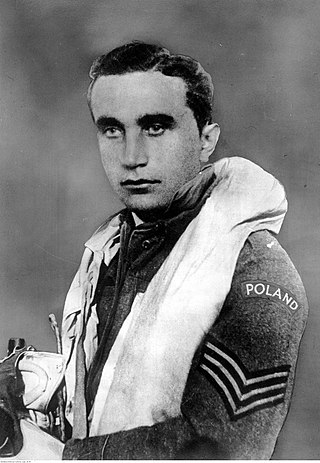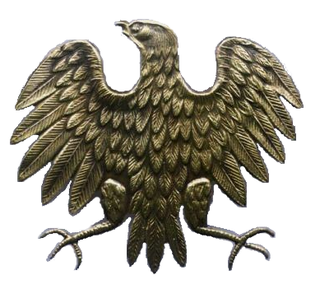
In World War II, the Polish armed forces were the fourth largest Allied forces in Europe, after those of the Soviet Union, United States, and Britain.[a] Poles made substantial contributions to the Allied effort throughout the war, fighting on land, sea, and in the air.

The military occupation of Czechoslovakia by Nazi Germany began with the German annexation of the Sudetenland in 1938, continued with the creation of the Protectorate of Bohemia and Moravia, and by the end of 1944 extended to all parts of Czechoslovakia.
The 1st Czechoslovak Independent Armoured Brigade Group was an armoured unit of expatriate Czechoslovaks organised and equipped by the United Kingdom during the Second World War in 1943.

Ludvík Svoboda was a Czech general and politician. He fought in both World Wars, for which he was regarded as a national hero, and he later served as the president of Czechoslovakia from 1968 to 1975.

Josef František was a Czechoslovak fighter pilot and Second World War fighter ace who flew for the air forces of Czechoslovakia, Poland, France, and the United Kingdom. He was the highest-scoring non-British Allied ace in the Battle of Britain, with 17 confirmed victories and one probable, all gained in a period of four weeks in September 1940.
The Royal Air Force (RAF) and Fleet Air Arm had included personnel from outside the United Kingdom from before the beginning of the Second World War, and many served in the Battle of Britain in summer 1940. Many of these volunteers were British subjects—thus, citizens—coming from territories that made up part of the British Empire. Additionally, a significant part was made up of refugees and exiles from German-occupied Europe and American emigrants.

Lieutenant General František Fajtl was a Czech fighter pilot of World War II. He was a British Royal Air Force (RAF) squadron and wing commander and led a group of Czechoslovak fighter pilots who formed an air regiment under Soviet Air Force command, supporting the Slovak National Uprising in 1944. He was dismissed from the Czechoslovak Air Force and was held in prison for a year and a half without a trial after the Communists came to power in 1948, and was only fully rehabilitated after the Velvet Revolution in 1989. He wrote many autobiographical books about his wartime experiences, and was an inspiration for the 2001 film Tmavomodrý svět.

The Allied leaders of World War II listed below comprise the important political and military figures who fought for or supported the Allies during World War II. Engaged in total war, they had to adapt to new types of modern warfare, on the military, psychological and economic fronts.

The Polish Armed Forces in the East, also called Polish Army in the USSR, were the Polish military forces established in the Soviet Union during World War II.

The Polish Armed Forces in the West refers to the Polish military formations formed to fight alongside the Western Allies against Nazi Germany and its allies during World War II. Polish forces were also raised within Soviet territories; these were the Polish Armed Forces in the East.

The Czechoslovak Air Force or the Czechoslovak Army Air Force was the air force branch of the Czechoslovak Army formed in October 1918. The armed forces of Czechoslovakia ceased to exist on 31 December 1992. By the end of the year, all aircraft of the Czechoslovak Air Force were divided between the Czech Air Force and the Slovak Air Force.
The Czech and Slovak Legion, also known as the Czechoslovak Legion, was a military unit formed in the Second Polish Republic after Germany occupied Czechoslovakia in March 1939. The unit took symbolic part in the defence of Poland during the German invasion on 1 September 1939.

The Polish Army in France formed in France under the command of General Władysław Sikorski in late 1939, after the fall of Poland resulting from the Polish Defensive War. About 85,000 troops were in the process of being organized into fighting formations when the Battle of France started. The army was partially destroyed in the hostilities, but over 20,000 soldiers were evacuated and formed a new Polish army in the United Kingdom.

The Czechoslovak Army was the name of the armed forces of Czechoslovakia. It was established in 1918 following Czechoslovakia's declaration of independence from Austria-Hungary.

Ján Ambruš, OBE was a Slovak aerobatics and fighter pilot. He flew with the French Air Force in the Battle of France and the Royal Air Force in the Battle of Britain. After the Communist takeover of Czechoslovakia he escaped and settled in the US, where he worked as a design engineer.

Karel Janoušek, was a senior Czechoslovak Air Force officer. He began his career as a soldier, serving in the Austrian Imperial-Royal Landwehr 1915–16, Czechoslovak Legion 1916–20 and Czechoslovak Army 1920–24.
Josef Jan Hanuš DFC was a Czechoslovak fighter pilot who served in first the French Air Force and then the Royal Air Force Volunteer Reserve (RAFVR) in the Second World War.

Otto Smik DFC was a Czechoslovak pilot of Slovak-Russian Jew origin who became a fighter ace in the Royal Air Force. He joined the Royal Air Force Volunteer Reserve in July 1940 and was in training until the end of 1942. Between March 1943 and June 1944 he shot down 13 Luftwaffe fighter aircraft probably shot down one more and shared in the shooting down of two others. In July 1944 he shot down three V-1 flying bombs. He became the highest-scoring Slovak fighter ace in the RAF.
Miloslav Mansfeld was a Czechoslovak fighter pilot who became a flying ace in the UK's Royal Air Force (RAF) in the Second World War.
The 1st Czechoslovak Composite Air Division was the air arm of the Czechoslovak armed forces in the Soviet Union during World War II, operating under the operational command of the Soviet Air Force. It existed during 1944 and 1945, being merged into the Czechoslovak Air Force upon the cessation of hostilities.













